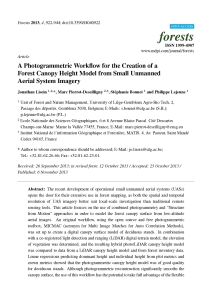Lisein J., Pierrot-Deseilligny M., Bonnet S., Lejeune P.
The recent development of operational small unmanned aerial systems (UASs) opens the door for their extensive use in forest mapping, as both the spatial and temporal resolution of UAS imagery better suit local-scale investigation than traditional remote sensing tools. This article focuses on the use of combined photogrammetry and “Structure from Motion” approaches in order to model the forest canopy surface from low-altitude aerial images. An original workflow, using the open source and free photogrammetric toolbox, MICMAC (acronym for Multi Image Matches for Auto Correlation Methods), was set up to create a digital canopy surface model of deciduous stands. In combination with a co-registered light detection and ranging (LiDAR) digital terrain model, the elevation of vegetation was determined, and the resulting hybrid photo/LiDAR canopy height model was compared to data from a LiDAR canopy height model and from forest inventory data. Linear regressions predicting dominant height and individual height from plot metrics and crown metrics showed that the photogrammetric canopy height model was of good quality for deciduous stands. Although photogrammetric reconstruction significantly smooths the canopy surface, the use of this workflow has the potential to take full advantage of the flexible revisit period of drones in order to refresh the LiDAR canopy height model and to collect dense multitemporal canopy height series.
Consultez la notice complète de l’article sur ORBi

